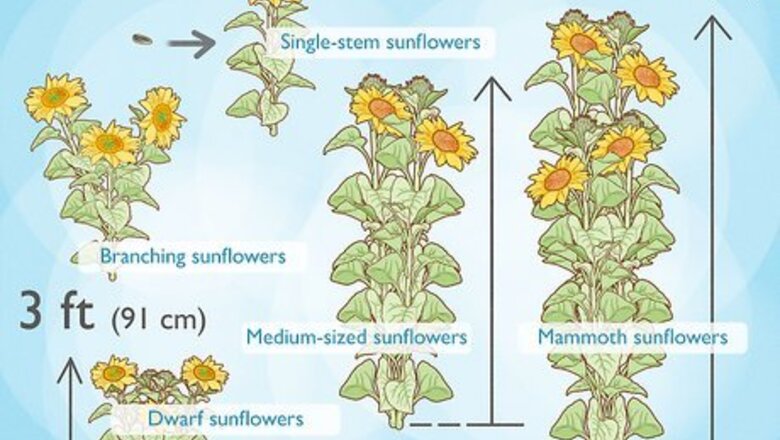
views
- Fill a 12-16 in (30-41 cm) pot that has drainage holes with well-draining soil. Then, push each seed 1 inch (2.5 cm) deep into the soil about 6 inches (15 cm) apart.
- Place the seeds in direct light indoors, keep the soil moist with daily waterings, and watch as they sprout in 7-10 days.
- Water sunflowers when their soil is dry, which is about once a week. Look out for flower blooms about 60 days after the seeds sprout.
Selecting a Sunflower Variety
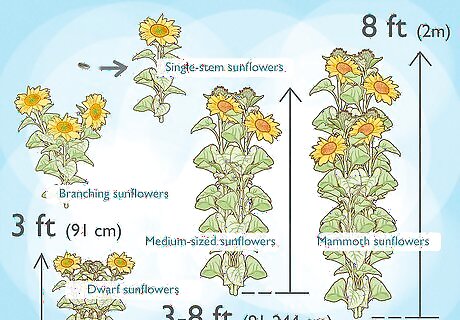
Pick a sunflower variety based on size and how many flowers it grows. Some sunflowers are super tall and grow several flower stems, while others are shorter and only produce 1 flower. Just look at each packet of sunflower seeds to see how tall the variety typically gets and how it grows flowers. If you're shopping at a nursery or garden center, ask an employee to tell you about the varieties they have. Single-stem sunflowers only grow 1 flower from 1 seed. If you want to cut the flowers, you'll have to plant multiple seeds at once. Single-stem varieties are often pollenless, so they’re great if you have bad allergies. Branching sunflowers produce many flowers from multiple stems throughout the growing season. Branching sunflowers also produce some of the more unusual colored flowers, including burgundy and chocolate. Dwarf sunflowers grow up to 3 feet (91 cm) tall. Some of the most popular types are Teddy Bear, Sunspot, and Ms. Mars. Medium-sized sunflowers, or semi-dwarf varieties, grow 3 to 8 feet (91-244 cm) tall. Popular types are Lemon Queen, Cappuccino, and Moulin Rouge. Mammoth sunflowers typically grow more than 8 feet (2 m) high. Some super tall sunflower varieties are Cyclops, Mammoth Russian, and American Giant. If this is your first time growing sunflowers in pots, pick a dwarf variety for the best results. Larger varieties tend to grow best in the ground. Look for rare, heirloom varieties of sunflowers online, such as on the nonprofit Seed Savers Exchange’s website.
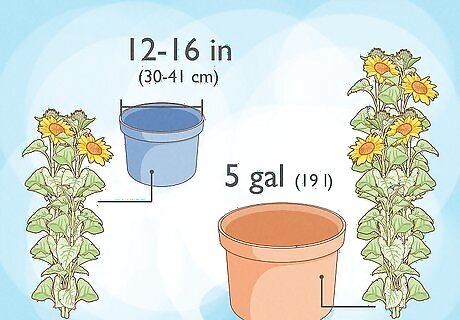
Use a pot with drainage holes that is 12-16 in (30-41 cm) wide. Choose a container based on the height of the flower you’re planting, as well as how many flowers you want to grow in the same container. Most dwarf sunflower varieties and medium-sized varieties need pots that are 12 to 16 in (30 to 41 cm) wide, while Mammoth sunflowers need at least a 5 gallon (19 l) container. If you're using an old pot, clean and sterilize it. If the pot doesn’t have drainage, cut a medium-sized hole into the bottom of the pot. For clay pots, drill a hole through the bottom. Include a plate or saucer under the container to catch run-off water. If you don’t use a pot with drainage holes, your seeds may rot.
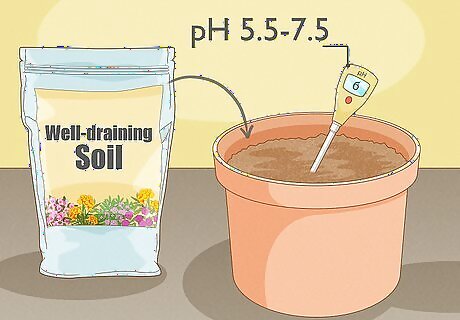
Fill the pot with well-draining soil and a handful of compost. Sunflowers don’t like to sit in wet soil, so fill the pot with a well-draining potting mix. Then, give your sunflower seeds some extra nutrients by mixing in a handful of compost to the soil. Look for quality potting mixes that have a pH between 5.5 and 7.5 and more than 3% organic content. You’ll find this info listed on the bag. When you use well-draining soil, you don't need to add any extra drainage material like sand or rocks to the bottom of the container. Adding sand or rocks can actually prevent the pot from draining properly.
Planting Your Seeds in a Pot
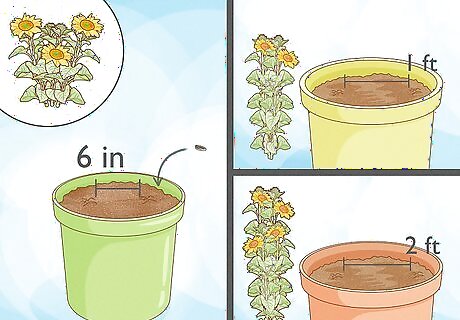
Push each seed 1 inch (2.5 cm) into the soil and 6 inches (15 cm) apart. If you're just planting 1 seed into each pot, sow the seed into the center of your container. If you’re planting multiple dwarf sunflower seeds, place each seed 6 inches (15 cm) apart. For medium-sized varieties, space the seeds 1 foot (30 cm) apart, and 2 feet (61 cm) apart for mammoth varieties. Start your seeds indoors about 4 to 6 weeks before your area’s last frost date, or the average last day of freezing temperatures. Once the seeds are fully sprouted, they’re safe to move outside if you want. When planting multiple seeds in a pot, space the seeds far enough from the edges of the container, too.
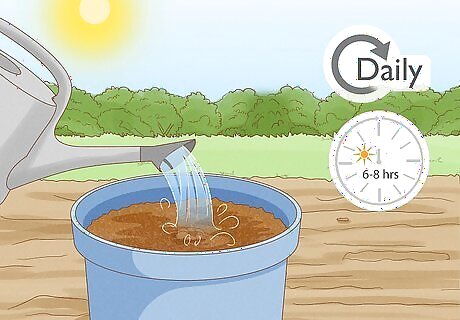
Place the seeds in full sun and water daily to keep the soil moist. As their name suggests, sunflowers need a lot of light to grow. So, find a spot indoors that gets about 6 to 8 hours of direct sunlight. The seeds also need a lot of water as they’re germinating. Just give the seeds a light watering each day to make sure the soil remains moist, but not overly wet. If you don’t have a sunny spot inside, place a grow light over the seeds. Sunflowers need a lot of water during germination so their stems grow strong enough to hold up their heavy flower head. If your pot is full of standing water, you might have a soil drainage problem. Just carefully repot the seed into a container with drainage holes and loose, well-draining soil.
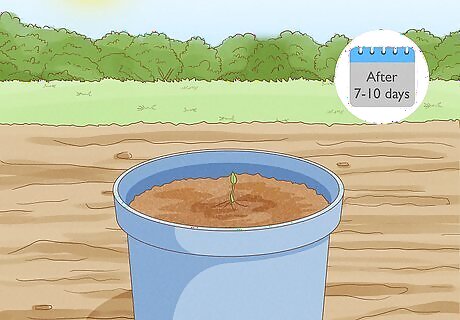
Monitor the soil moisture and watch the seeds germinate in 7-10 days. The great thing about growing sunflowers is that they germinate quickly. You only have to wait about 7 to 10 days for your sunflower seeds to sprout out of the soil. During this time, continue to lightly water the seeds every day and make sure the soil is moist, particularly around the seeds.
Caring for Your Sunflower
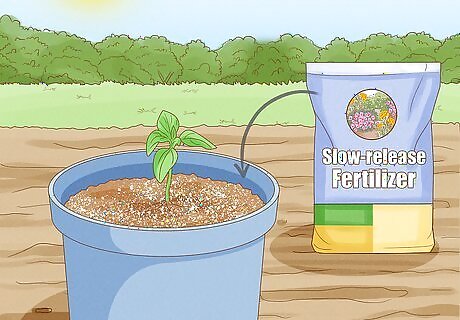
Add slow-release fertilizer when the seedling has 2 sets of leaves. While sunflowers don't necessarily need additional food to grow, fertilizer can help them grow faster and make the blooms larger and more vibrant. Add a balanced, slow-release fertilizer to the soil, following the directions listed on the fertilizer’s label. Or, add diluted fertilizer to your sunflower's water. Follow the fertilizer’s instructions so you don’t over-fertilize your sunflower, which can cause the stem to break.
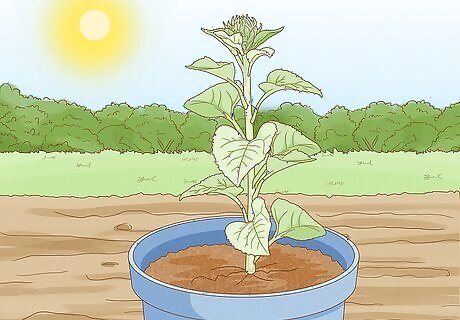
Keep your sunflower in bright, direct sunlight. As the seedlings grow, they need as much sunlight as they can get. This helps their stems grow big and strong to support the large flower heads. Just keep them in a spot indoors or outside that gets 6 to 8 hours of sun each day. If your sunflowers are outside, cover the seedlings with baskets or netting to protect them from birds. Place the seedlings under a grow light if you don’t get a lot of bright, direct light. Sunflowers are heliotropic, which means their heads follow the path of the sun. If they’re not placed in direct sunlight, they will bend towards the sun, which can damage their stem over time.
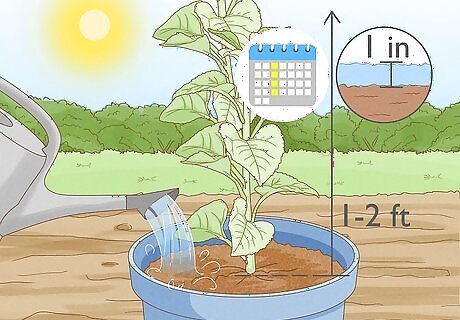
Water your sunflower about once a week to keep the soil moist. Check your sunflower’s soil every few days by sticking your finger about 1 inch (2 cm) deep into the soil. If it feels dry, give your sunflowers a good soak. Generally, sunflowers need about 1 inch (2 cm) of water per week. If your sunflowers are outside, they are typically fine with just receiving rainwater after they grow 1 to 2 feet (0.30 to 0.61 m) tall. However, you may need to water them if you have a scorching, dry day.
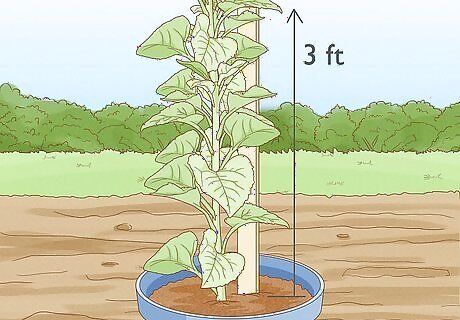
Support sunflowers taller than 3 feet (91 cm) with a stake. Place a 6-foot (1.8 m) gardening stake about 1 foot (30 cm) away from each sunflower. Then, use a mallet or hammer to drive the stake about 1 foot (30 cm) deep into the ground. Simply use gardening ties or yarn to secure the flower stalk to the stake. If you’re growing your sunflowers indoors, tie the stalk to a sturdy object like a wall or pipe. While you can add a stake directly into the pot, the weight of the plant and the stake might tip the pot over. Most dwarf varieties don’t grow tall enough to need support.
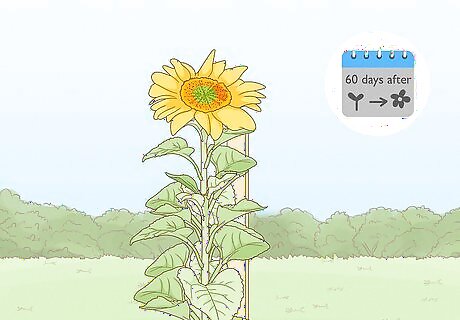
Watch for flower blooms about 60 days after the seedlings sprout. Most sunflower varieties start to bloom in the middle of the summer, which is about 60 days after the seeds germinate in the spring. They typically keep blooming until early fall, so if you forget to plant them in the spring, they’ll still flower when planted in late summer.
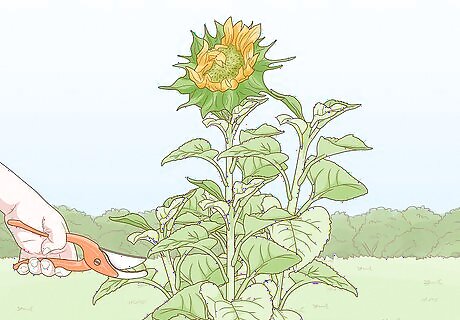
Cut off flowers above a set of leaves when they’re starting to unfurl. The best time to snip off flowers for beautiful bouquets is right when the flowers are unfurling. They’ll open completely when you put them in a vase full of water and last a lot longer. Just cut off the flower stem right above a set of leaves. If you have a branching variety, this encourages a new stem to grow at the cut point. If you have a single-stem variety, a new flower won’t grow on the stem after you cut it off.
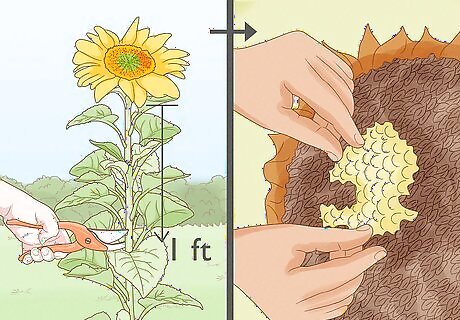
Harvest the seeds when the back of the flower head turns brown. If you have a sunflower variety with edible seeds, let the flower die on the stem. Then, cut the stem about 1 foot (30 cm) below the flower and hang it upside down in a warm, dry place. After about a week, check if the seeds are fully dry. If they are, just brush the flower head with your hands or a stiff brush to remove the seeds. Generally, sunflower seeds that are black or gray with white stripes are edible. Look up your variety online to make sure it’s okay to eat its seeds. If your sunflowers are outside, cover them with netting or a paper bag to keep the birds from eating all your seeds. Once dried, roast the seeds as a snack or store them in an air-tight container at room temperature for up to 4 months. If you want to store them for longer, place them in your freezer. Eat the sunflower’s buds, too! Blanch them first to remove their bitterness, then steam or boil them for 3 minutes. They are delicious when tossed in homemade garlic butter.




















Comments
0 comment